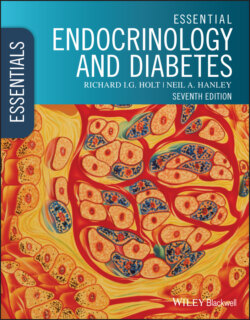Читать книгу Essential Endocrinology and Diabetes - Richard I. G. Holt - Страница 44
Enzyme action and cascades
ОглавлениеEnzymes can be divided into classes according to the reactions they catalyze (Table 2.1). In endocrinology, they frequently operate in cascades where the product of one reaction serves as the substrate for the next. The most simplistic representation of an enzymatic reaction is a physical interaction between the substrate and the enzyme at the latter’s ‘active site’. This proximity catalyzes a molecular modification of the substrate into the product. The product has less affinity for the active site and is released. Other macromolecules can also bind to the enzyme outside the active site and function as co‐factors, adding more complex regulation to the biochemical reaction.
Table 2.1 Definition and classification of enzymes
| Definition | ||
| An enzyme is a biological macromolecule – most frequently a protein – that catalyzes a biochemical reaction | ||
| Catalysis increases the rate of reaction, e.g. the disappearance of substrate and generation of product | ||
| Enzyme action is critical for the synthesis of hormones derived from amino acids and cholesterol | ||
| Classification | ||
| Enzyme | Catalytic function | Example (and relevance) |
| Hydrolases | Cleavage of a bond by the addition of water | Cytochrome P450 11A1/cholesterol side‐chain cleavage (CYP11A1; an early step in steroid hormone biosynthesis) |
| Lyases | Removal of a group to form a double bond or addition of a group to a double bond | Cytochrome P450 17α‐hydroxylase/17–20 lyase (CYP17A1; step in the synthesis of steroid hormones other than aldosterone) |
| Isomerases | Intramolecular rearrangements | 3β‐Hydroxysteroid dehydrogenase/δ‐4,5‐isomerase isoforms (HSD3B; a step in the synthesis of many major steroid hormones) |
| Oxidoreductase | Oxidation and reduction | 11β‐Hydroxysteroid dehydrogenase isoforms (HSD11B; inter‐conversion of cortisol and cortisone) |
| Ligases or synthases | Join two molecules together | Thyroid peroxidase (TPO; a step in the synthesis of thyroid hormone) |
| Transferases | Transfer of a molecular group from substrate to product | Phenolethanolamine N‐methyl transferase (PNMT; conversion of norepinephrine to epinephrine) |
Patients can present with many endocrine syndromes because of loss of enzyme function. For instance, gene mutation might lead to substitution of an amino acid at a key position of an enzyme’s active site. The three‐dimensional structure might be affected so significantly that the substrate is no longer converted to product. In the enzyme cascade that synthesizes cortisol, such mutations can cause various forms of congenital adrenal hyperplasia (CAH) (Chapter 6). Understanding the biochemical cascade allows accurate diagnosis as the product is lacking while the substrate builds up and can be measured, e.g. by immunoassay or mass spectrometry (Chapter 4).
